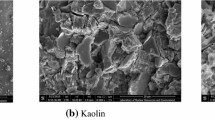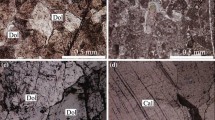Abstract
Effects of impurities (SOx, NOx and O2) from the extraction processes of the power plants in the scCO2 fluids are studied with an experimental approach combining geochemical alteration in high p, medium T autoclaves, compressional tests in a heated triaxial testing device as well as geochemical and mineralogical analyses before and after the influences of distinct scCO2 fluids on 140 × 70 mm sized samples of reservoir sandstones from the North German Basin (with carbonate cementation, silicate cementation and a combined silicate-carbonate cementation). On the background of variable lithological compositions, the attempt was made to normalize the scattering geomechanical data by the pure CO2-behavior measurement data to achieve a direct impression of any differences due to the impurities. Changes in the chemical composition of the saline fluids were systematically measured during the scCO2 alteration experiments in the autoclave systems at distinct pT conditions. The development of the silica concentrations and of the pH value in the fluid solution during alteration showed a clear dependency on the fluid composition. Through systematical analysis of changes on the mineral surfaces using SEM microscopy images before and after scCO2 + impurities alteration experiments or triaxial compression tests, corrosion effects were detected, but no differences which could be directly related to differences in the fluid composition could be identified. In all the types of sandstones, visible or measurable changes on mineral surfaces and pore fluid composition, respectively, take place as an interaction of rock with fluids of scCO2 with and without impurities. Changing deformability and compressive strength of the rocks are the most apparent consequences due to these compositional changes. It is supposed that the chemical fluid differences are responsible for these changes. Also a specific distribution of the different fluids in the ambient pore space is indicated with even undetected consequences for the fluid influence on stress transmission and distribution within the grain structure. All work was performed within the project “CO2 purity for capture and storage (COORAL)” supported by the German Federal Ministry for Economic Affairs and Energy.
















Similar content being viewed by others
References
Al-Siyabil I (2013) Effect of Impurities on CO2-Stream Properties. Dissertation, Heriot-Watt-University Edinburgh, Scotland
Atkinson BK, Meredith PG (1981) Stress corrosion cracking of quartz: a note on the influence of chemical environment. Tectonophysics 77(1–2):1–11
Atkinson BK, Meredith PG (1987) The theory of subcritical crack growth with application to minerals and rocks. In: Atkinson BK (ed) Fracture Mechanics of Rock. Academic press, London, pp 111–166
Azaroual M, Pruess K, Fouillac C (2007) Feasibility of using supercritical CO2 as heat transmission fluid in the EGS (Enhanced Geothermal Systems) integrating the carbon storage constraints. ENGINE-Enhanced Geothermal Innovative Network for Europe. Workshop 2, Volterra Italy
Bachu S, Bennion DB (2009) Chromatographic partitioning of impurities contained in a CO2 stream injected into a deep saline aquifer: part 1. Effects of gas composition and in situ conditions. Int J Greenhouse Gas Control 3:458–467
Bryant S, Lake LW (2005) Effect of impurities on subsurface CO2 storage processes. In: Thomas DC, Benson SM (eds) Carbon dioxide capture for storage in deep geologic formations—results from the CO2 capture project, vol 2. Elsevier, London, pp 983–996
Corvisier J, Bonvalot A-F, Lagneau V, Chiquet P, Renard S, Sterpenich J, Pironon J (2013) Impact of co-injected gases on CO2 storage sites: geochemical modeling of experimental results. Energy Procedia 37:3699–3710
Dawson GKW, Pearce JK, Biddle D, Golding SD (2014) Experimental mineral dissolution in Berea Sandstone reacted with CO2 or SO2-CO2 in NaCl brine under CO2 sequestration conditions. Chem Geol. doi:10.1016/j.chemgeo.2014.10.005
Ellis BR, Crandell LE, Peters CA (2010) Limitations for brine acidification due to SO2 co-injection in geologic carbon sequestration. Int J Greenhouse Gas Control 4:575–582
Etheridge MA (1983) Differential stress magnitudes during regional deformation and metamorphism: upper bound imposed by tensile fracturing. Geology 11:231–234
Farquhar SM, Pearce JK, Dawson GKW, Golab A, Sommacal S, Kirste D, Biddle D, Golding SD (2014) A fresh approach to investigating CO2 storage: experimental CO2 water rock interactions in low-salinity reservoir system. Chem Geol. doi:10.1016/j.chemgeo.2014.10.006
Fischer C, Gaupp R, Dirnke M, Sill O (2007) A 3D high resolution model of bounding surfaces in aeolian-fluvial deposits: an outcrop analogue study from the Permian Rotliegend. North Ger J Pet Geol 30(3):257–274
Fischer C, Dunkl I, von Eynatten H, Wijbrans JR, Gaupp R (2012) Products and timing of diagenetic processes in Upper Rotliegend sandstones from Bebertal (North German Basin, Parchim Formation, Flechtingen High, Germany). Geol Mag 149(5):827–840
Glezakou V-A, McGrail BP, Schaef HT (2012) Molecular interactions of SO2 with carbonate minerals under co-sequestration conditions: a combined experimental and theoretical study. Geochim Cosmochim Acta 92:265–274
Hast N (1979) Limits of stress measurements in the earth´s crust. Rock Mechanics 11:143–150
Heinzelmann W (1969) Der Untere und der Mittlere Buntsandstein auf Blatt Nebra. Hall Jb Mitteldt Erdgesch 9:132–160
IEAGHG (2011) Effects of impurities on geological storage of CO2, 2011/04
Kather A, Paschke B, Kownatzki S (2013) COORAL-Abschlußbericht: Teilprojekt Probengasdefinition, Transportnetz und Korrosion. 01.04.2009–31.12.2012 IET Univers. Hamburg-Harburg, pp 1–138
Kerrich R, La Tour TE, Barnett RL (1981) Mineral reactions participating in intragranular fracture propagation: implications for stress corrosion cracking. J Struct Geol 3:77–87
Kharaka YK, Cole DR, Havorka SD, Gunther WD, Knauss KG, Freifeld BM (2006) Gas-water-rock interactions in Frio Formation following CO2-injection: implications for the storage of greenhouse gases in sedimentary basins. Geology 34:577–580. doi:10.1130/G22357.1
Knauss KG, Johnson JW, Steefel CI (2005) Evaluation of the impact of CO2, co-contaminant gas, aqueous fluid and reservoir rock interactions on the geologic sequestration of CO2. Chem Geol 217:339–350
Koenen M, Tambach TJ, Neele FP (2011) Geochemical effects of impurities in CO2 on a sandstone reservoir. Energy Procedia 4:5343–5349
Kummerow J, Spangenberg E (2011) Experimental evaluation of the impact of the interactions of CO2–SO2, brine and reservoir rock on petrophysical properties: a case study from the Ketzin test site, Germany. Geochem Geophy Geosyst 12(5):10
Landrot G, Ajo-Franklin JB, Yang L, Cabrini S, Steefel CI (2012) Measurement of accessible reactive surface area in a sandstone, with application to CO2 mineralization. Chem Geol 318–319:113–125
Li H, Yan J (2009) Impacts of equations of state (EOS) and impurities on the volume calculation of CO2 mixtures in the applications of CO2 capture and storage (CCS) processes. Appl Energy 86:2760–2770
Luquot L, Andreani M, Gouze P, Camps P (2012) CO2 percolation experiment through chlorite/zeolite-rich sandstone (Pretty Hill Formation—Otway Basin-Australia). Chem Geol 294–295:75–88
Main IG, Sammonds PR, Meredith PG (1993) Application of a modified Griffith criterion to the evolution of fractal damage during compressional rock failure. Geophys J Int 115:367–380
Marbler H, Erickson KP, Schmidt M, Lempp C, Pöllmann H (2013) Geomechanical and geochemical effects on sandstones caused by the reaction with supercritical CO2: an experimental approach to in situ conditions in deep geological reservoirs. Environ Earth Sci 69:1981–1998
Meredith PG, Atkinson BK (1983) Stress corrosion and acoustic emission during tensile crack propagation in Whin Sill dolerite and other basic rocks. Geophys J R Astr Soc 75:1–21
Nicot J-P, Solano S, Lu J, Mickler P, Romanak K, Yang C, Zhang X (2013) Potential Subsurface Impacts of CO2 Stream Impurities on Geological Carbon Storage. Energy Procedia 37:4552–4559
Ovaysi S, Piri M (2013) Pore-scale dissolution of CO2 + SO2 in deep saline aquifers. Int J Greenhouse Gas Control 15:119–133
Pearce JK, Dawson GKW, Farquhar S, Golding SD (2013) SO2 and O2 co-injection with potential carbon storage target sandstone from a fresh-water aquifer. Miner Mag 77(5):1942. doi:10.1180/minmag.2013.077.5.16
Radzinski KH (1966) Stratigraphische und paläontologische Untersuchungen im Unteren und Mittleren Buntsandstein des südöstlichen Harzvorlandes. Dissertation, Universität Greifswald
Radzinski KH (1995) Zum Unteren und Mittleren Buntsandstein im Unstruttal bei Nebra (Südwestrand der Querfurter Mulde). Mitteilungen des Geol. Inst. der Univ. Hannover 1995, 107 Seiten
Renard S (2010) Rôle des gaz annexes sur l`évolution géochimique d´un site de stockage de dioxide de carbone. Application à des reservoir carbonates. Dissertation, Université de Lorraine, Nancy
Renard S, Sterpenich J, Pironon J, Randi A, Chiquet P, Lescanne M (2011a) Impact of SO2 and NO on carbonated rock submitted to a geological storage of CO2: an experimental study. In: Wu Y, Carrol JJ (eds) Acid gas injection and related technologies. Scrivener publishing, Calgary, pp 377–392
Renard S, Sterpenich J, Pironon J, Chiquet P, Lescanne M, Randi A (2011b) Geochemical study of the reactivity of a carbonate rock in a geological storage of CO2: implications of co-injected gases. Energy Procedia 4:5364–5369
Renard S, Sterpenich J, Pironon J, Chiquet P, Randi A (2014) Geochemical effects of an oxycombustion stream containing SO2 and O2 on carbonate rocks in the context of CO2 storage. Chem Geol 382:140–152
Riedel E (2004) Anorganische Chemie, 6th edn. De Guyter, Berlin
Röckel Th, Lempp Ch (2003) The State of Stress in the North German Basin. Erdöl Erdgas Kohle 119(2):73–80
Schmidt M, Pöllmann H, Marbler H, Erickson K, Lempp Ch (2010) Construction of an autoclave system for the study of geochemical/mineralogical rock behavior under reservoir conditions during the sequestration of CO2: first results of the COORAL project. 88. Jahrestagung der DMG, Münster
Schmidt M, Pöllmann H, Marbler H, Erickson K, Lempp Ch (2011a) A new autoclave system for the “in situ”-investigation of carbonation reactions of basic rocks with waste CO2. IODP/ICDP Workshop Geol. Capture and Storage in mafic and ultramafic rocks Muscat/Oman, Abstracts
Schmidt M, Marbler H, Erickson K, Lempp Ch, Pöllmann H (2011b) Use of an autoclave system for the study of geochemical/mineralogical rock behaviour under reservoir conditions during the geological storage of CO2: results of the COORAL project. Joint Meeting DGK, DMG und ÖMG. Crystals, Minerals & Materials, Salzburg
Sterpenich J, Dubessy J, Pironon J, Renard S, Caumon M-C, Randi A, Jaubert J-N, Favre E, Roizard D, Parmentier M, Azaroual M, Lachet V, Creton B, Parra T, El Ahmar E, Coquelet C, Lagneau V, Corvisier J, Chiquet P (2013) Role of impurities on CO2 injection: experimental and numerical simulations of thermodynamic properties of water-salt-gas mixtures (CO2+ co-injected gases) under geological storage conditions. Energy Procedia 37:3638–3645
Verma S, Oakes CS, Chugunov N, Ramakrishnan TS (2011) Effect of contaminants on the thermodynamic properties of CO2-rich fluids and ramifications in the design of surface and injection facilities for geologic CO2 sequestration. Energy Procedia 4:2340–2347
Wang J, Ryan D, Anthony EJ, Wildgust N, Aiken T (2011) Effects of Impurities on CO2 Transport, Injection and Storage. Energy Procedia 4:3071–3078
Wang J, Ryan D, Anthony EJ, Wigston A, Basava-Reddi L, Wildgust N (2012) The effect of impurities in oxyfuel flue gas on CO2 storage capacity. Int J Greenhouse Gas Control 11:158–162
Wilke FDH, Vásquez M, Wiersberg T, Naumann R, Erzinger J (2012) On the interaction of pure and impure supercritical CO2 with rock forming minerals in saline aquifers: an experimental approach. Appl Geochem 27:1615–1622
Zhu W, Li G, Wang K (1985) Analysis of discing phenomenon and stress field in the region of an underground powerhouse. Rock Mech Rock Eng 18(1):1–15
Acknowledgments
The work was carried out within the German national project COORAL (“CO2 Purity for Capture and Storage”), which is financially supported by the Federal Ministry of Economics and Technology (Grant-ID: 032779D). Third party funding was provided by ALSTOM, EnBW, E.ON, Vattenfall and VNG. The authors gratefully acknowledge the work of M. Schmidt, who executed and evaluated most geochemical tests and Dr. H. Marbler who evaluated some of the data for this study. We also would like to thank the technicians of the Martin-Luther-University Halle-Wittenberg for executing all geomechanical tests and the geochemical analytical work. ZWL Lauf helped tremendously performing the high-resolution SEM investigations. We gratefully acknowledge the suggestions of Dr. M. Azaroual and two anonymous reviewers. Lastly, we would like to thank Mr. D. Erickson for English proof reading.
Author information
Authors and Affiliations
Corresponding author
Rights and permissions
About this article
Cite this article
Erickson, K.P., Lempp, C. & Pöllmann, H. Geochemical and geomechanical effects of scCO2 and associated impurities on physical and petrophysical properties of Permotriassic Sandstones (Germany): an experimental approach. Environ Earth Sci 74, 4719–4743 (2015). https://doi.org/10.1007/s12665-015-4437-0
Received:
Accepted:
Published:
Issue Date:
DOI: https://doi.org/10.1007/s12665-015-4437-0




